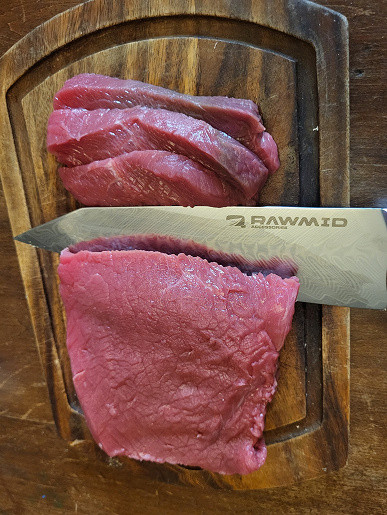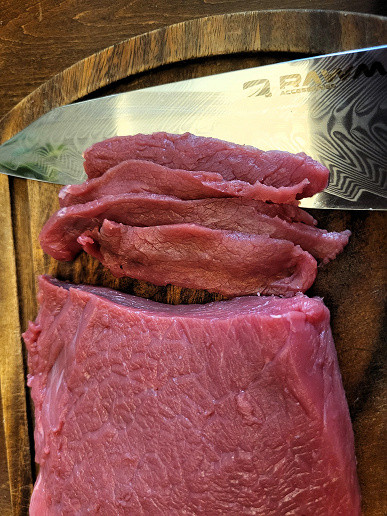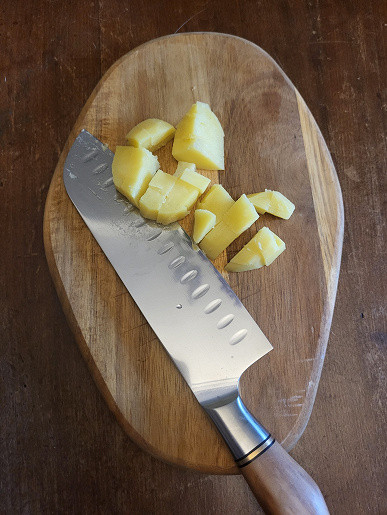Ever since we received a set of Rawmid knives, a line from Mityaev’s song has been spinning in our heads: “if there are no knives sharpened in the house.” It is obvious that working with dull and low-quality knives is not only inconvenient, but also dangerous. This set of knives leaves a pleasant impression with its design, quality and beauty of the blades.
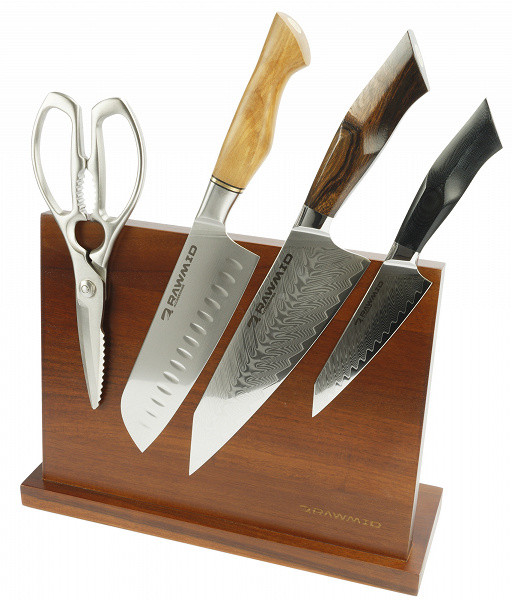
Let's see if these knives are as good as they look.
Characteristics
We received knives from different sets for testing and tried to combine information about them in one table.
| Manufacturer | Rawmid | |||
|---|---|---|---|---|
| Model | Chef's knife Rawmid Luxury RLK-22 ironwood | Santoku Rawmid Classic RCK-18 | Universal Rawmid Luxury RLK-13 plexiglass | Scissors RCS-01 |
| Type | kitchen knife | kitchen scissors | ||
| Country of Origin | China | |||
| Guarantee | 1 year | |||
| Blade steel | in the center — high-carbon steel 10Cr15CoMoV, on the sides — low-carbon stainless steel AISI 316 | high strength steel grade 14C28N | in the center — high-carbon steel 10Cr15CoMoV, on the sides — low-carbon stainless steel AISI 316 | durable stainless steel grade 3Cr14 |
| Blade manufacturing technology | «Damascus steel» | «Scandinavian steel» | «Damascus steel» | not indicated |
| Blade hardness | 62 HRC | 58 HRC | 62 HRC | not indicated |
| Edge angle | 15° | 15° | 15° | not indicated |
| Blade length | 22 cm | 18 cm | 13 cm | not indicated |
| Lever | desert ironwood | olive Tree | fiberglass | stainless steel grade 3Cr14 |
| Application | cutting, peeling, chopping, shredding various products: vegetables, fruits, mushrooms, meat and fish, sausage, bread, cheese, etc. | slicing wet foods such as tomatoes or cheese | cutting, shredding, peeling and chopping any products | cut greens, cut meat and fish, open packages and bottles, crack nuts |
Equipment
The knives and scissors for testing arrived in thick black cardboard packaging. This was not ordinary box cardboard, which is usually used for packaging devices, but gift cardboard — thick and pleasant to the touch. The name of the manufacturer was written on the box in blue shiny letters.

Having opened three boxes, we found:
- knives
- manuals
- and warranty cards
Having opened the fourth one, we found scissors there along with the manual and warranty card.
At first sight
So, four items arrived for testing:
- chef knife Rawmid Luxury RLK-22 ironwood
- Santoku knife Rawmid Classic RCK-18
- utility knife Rawmid Luxury RLK-13 plexiglass
- scissors RCS-01
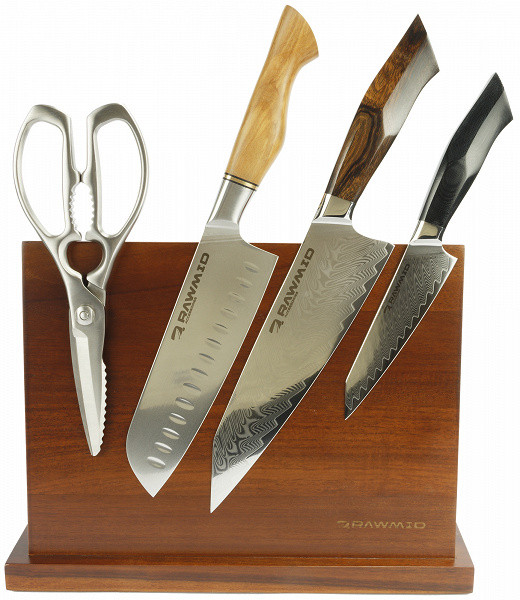
We have already mentioned the quality of the box and packaging, but when we opened them, we were captivated by the beauty of the knives, especially those made of Damascus steel. The pattern on the blade is a real aesthetic pleasure.
The chef's knife, which is the basic element of the «chef's troika» (together with a vegetable knife, which, unfortunately, we did not get, and a utility knife), allows you to complete up to 90% of the work of preparing food for cooking.
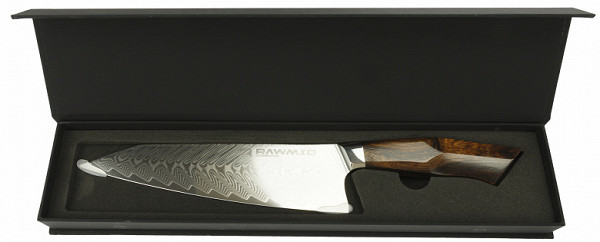

We were told on the Internet that the functionality of a chef's knife and a Santoku knife differs slightly. The name «santoku» itself translates to «three advantages», which means it is intended for three main actions: slicing, chopping and shredding. In the Japanese tradition, santoku is considered ideal for thin slicing (slicing), dicing and finely shredding meat for minced meat. Santoku is also preferred for working with soft or prepared foods.
The blade of a Santoku knife has grooves that lighten its weight and prevent food from sticking.
Cutting with a Santoku knife uses a downward motion with little or no forward motion. Thus, the santoku works almost like a guillotine, which allows you to cut food into very thin pieces. When working with a chef's knife, a slightly different movement is used: the tip of the knife constantly touches the board, only the base of the blade is raised, and the product is moved under the cutting edge with your free hand.
The choice between these two types of knives depends on your preferences. Santoku is called a lightweight knife for smooth and leisurely slicing soft foods in large quantities, which will be especially appreciated by women who have to cook a lot.
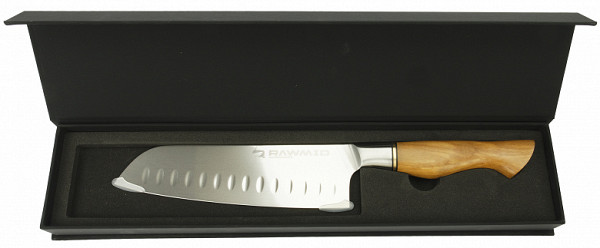

A utility knife is rightfully considered universal, as it is suitable for everything. But the utility knife Rawmid Luxury RLK-13 plexiglass made a special impression on us. It blew us away with its gorgeous steel pattern and fiberglass handle, a material known for its high hardness, strength and durability. This material is also hygienic, not susceptible to rotting, moisture and insect pests. The handles of other knives that were delivered to us, made of iron or olive wood, have similar characteristics. Therefore, the choice of handle depends on your preferences: modern high-tech materials or traditional wood.
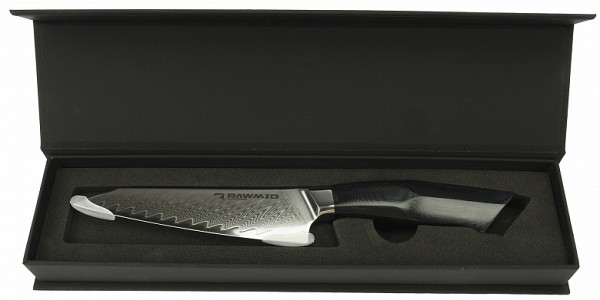

And the last item is stainless steel scissors. Scissors, of course, are also multifunctional: you can use them to cut herbs and pizza, butcher meat or poultry, chop walnuts and open glass bottles.

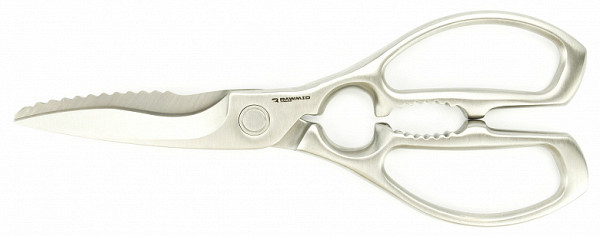
The whole set gives the impression of being beautiful, stylish and expensive. These are objects that are pleasant to hold in your hands.
Instructions
The instructions are an A5 sheet, folded in half vertically, made of thick matte paper.

The instructions describe in detail the preparation of the knife before use, care and maintenance, methods of sharpening the knife, and also gives tips on manual sharpening of knives.
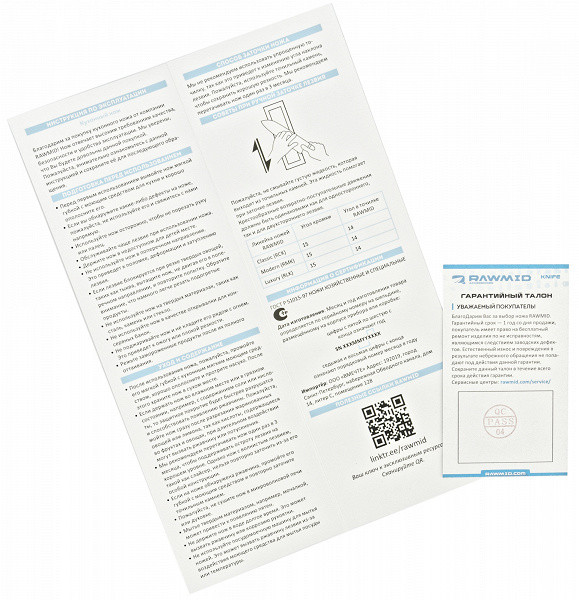
Exploitation
Before the first use, we, of course, washed the knives with a soft sponge and detergent and rinsed them thoroughly.
As for use… We still have a favorite antique knife in our kitchen, inherited from our grandmother or even great-grandmother. It is clear that knives are rarely sharpened (returning to Mityaev: “he will be embarrassed that the knives are not sharp”), and when we picked up the Rawmid knives… The first thing that happened was that we cut ourselves with the sharp end of the Santoku knife. Then we cut the lemon with a utility knife, and the feeling we experienced… (maybe we are too carried away with ellipses today, but this is solely due to an excess of emotions for knives). So, the feeling was like this… You know when they say “it’s going like clockwork”? So, these knives cut lemon, tomato, potato and meat just as easily. The lemon turned out to be cut into the thinnest transparent slices, which just begs to be paired with a glass of cognac.
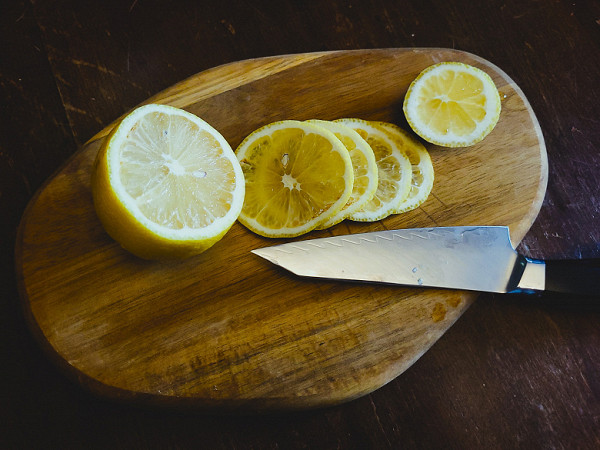
We have ceramic knives that don't need to be sharpened, so we always consider them sharp. However, we don’t dare peel potatoes with a ceramic knife for fear of cutting ourselves. But for all other kitchen operations they are suitable. For example, cut a tomato. How to describe the sensation of cutting a tomato with a ceramic knife, a knife from the Trud factory, or those provided to us for testing? Probably, when working with a sharp scalpel, the surgeon feels the same as we do when cutting a tomato with a Rawmid utility knife. Accuracy, speed, ease and beauty of the cut.
The only negative thing we noticed while writing the review was the small spots of rust that appeared on the Santoku knife. The blade is made from high-strength 14C28N steel, but we couldn't find any indication that it was stainless steel.

Our knives were stored in the same conditions: after use, we washed them and wiped them dry. However, since they were stored in the kitchen, it is possible that some drop of water did get onto the blade. This problem did not arise with the other two knives: their blades remained without stains or darkening. In response to our question, the manufacturer suggested that the problem might be in contact with the stand. “When placing knives in the stand, they must be thoroughly wiped dry, otherwise they may react and stain when they come into contact with the material of the stand.”
Care
After use, it is recommended to wash the knife with a soft sponge and detergent, then rinse and dry, especially after cutting pickled vegetables or lemon, as the acids they contain can cause rust or dulling of the blade. For the same reason, knives should not be left in water for a long time and should not be washed in the dishwasher. They should be stored in a dry place.
Do not heat the knife or dry it in the microwave or oven.
It is recommended to sharpen knives once every three months, avoiding the use of simplified sharpeners that can change the angle of the blade. The manufacturer recommends using a whetstone to sharpen knives.
Practice tests
We tested with all the knives and scissors provided to us. Sometimes the results varied depending on the purpose of each tool, and sometimes we decided to do comparison tests using different knives for the same products. Let's see what we got.
Chef's knife Rawmid Luxury RLK-22 ironwood
For the first test of the knife, we took a piece of beef and cut it — first into thick pieces, then thin (well, how thin we can cut — not always everything depends on the knife).
We were completely satisfied with the result: the knife did an excellent job cutting meat.
Next we tried cutting carrots — the root vegetable is known to be very hard. The knife did an excellent job with this task.
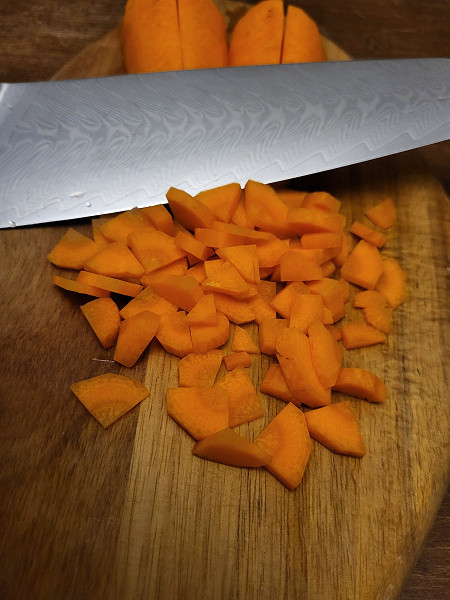
The cucumbers were also thinly sliced.
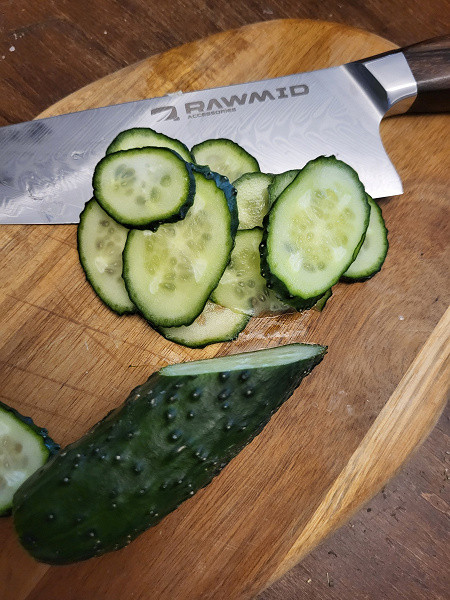
And we tried the knife on hard smoked sausage, which we also managed to cut quite thinly (we remind you that not everyone knows how to make thin slices).
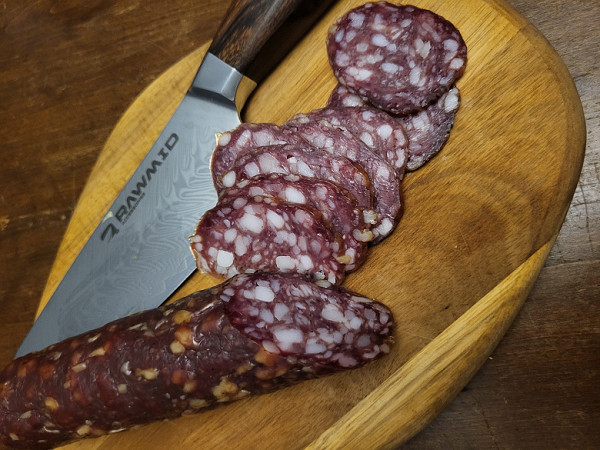
Result: excellent
Santoku knife Rawmid Classic RCK-18
Since the Santoku knife is designed for slicing soft and cooked foods, we decided to try cutting boiled potatoes with it — and we succeeded. However, we are not sure that the notches on the knife blade actually played a role. The theory is that they should lighten the weight of the knife and prevent food from sticking to the blade. However, cheese and boiled potatoes still stick a little to the blade, although these foods can stick to anything.
We also used a santoku knife to cut a cucumber, but not into slices, but into cubes. However, the knife copes well with thin slicing.
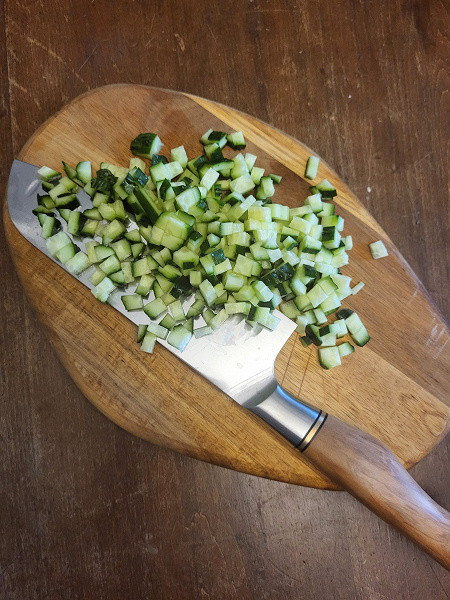
Like the chef's knife, we tried the santoku knife on meat — in thick and thin cuts. It's hard to say which knife did a better job; it seemed to us that both of them did an equally good job.
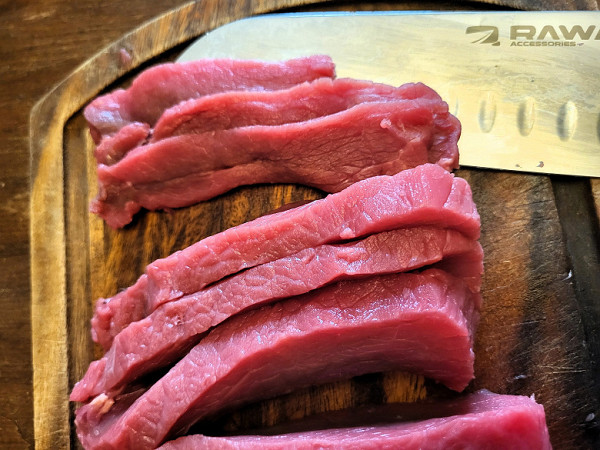
And the last product was hard smoked sausage, which the knife also did an excellent job with.
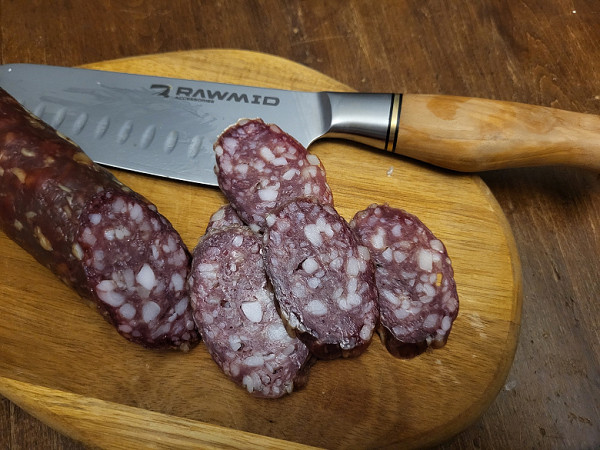
Result: excellent
Utility knife Rawmid Luxury RLK-22 plexiglass
Working with a utility knife also did not cause us any complaints. The knife did an excellent job of cutting lemon:
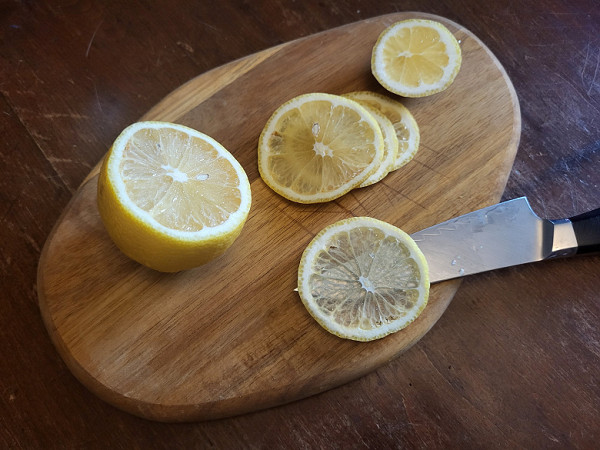
And with chopped onions:

We also tried it on sausage, but something went wrong here — perhaps our hand was no longer as steady as in previous cases, or the knife really didn’t work that well: sometimes we ended up with slices of sausage that weren’t quite even, but slightly truncated (as can be seen in the photo on the knife blade).
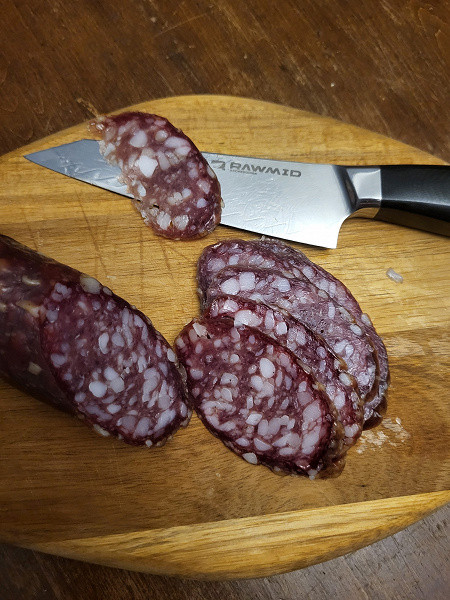
However, we still give it an «excellent» rating because we have used this knife not only in our on-camera tests, but also in regular cooking, and it has never let us down.
Result: excellent
Scissors RCS-01
The description of the scissors states that they can perform various functions: cutting herbs, cutting meat and fish, opening packages and bottles, chopping nuts. We decided to test almost all of these possibilities. The first thing we did was use them to chop green onions, and the task was successfully completed.

We also tested the scissors by trying to cut the knuckle off a chicken drumstick, and we were able to do that too. The main thing here, as in working with a knife, is to get to the right place.
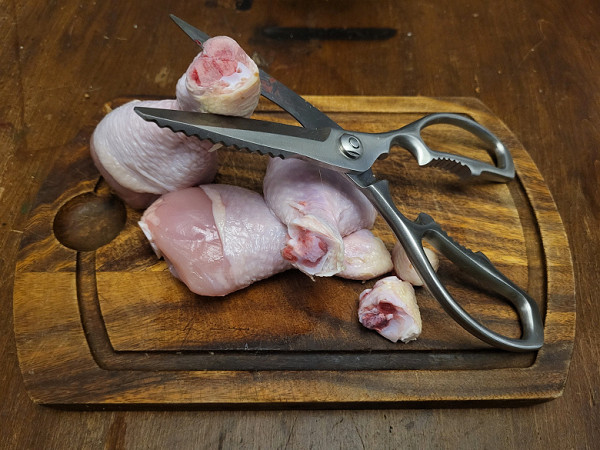
Finally, we tried cracking walnuts with scissors, and you can see the result in the photo below.
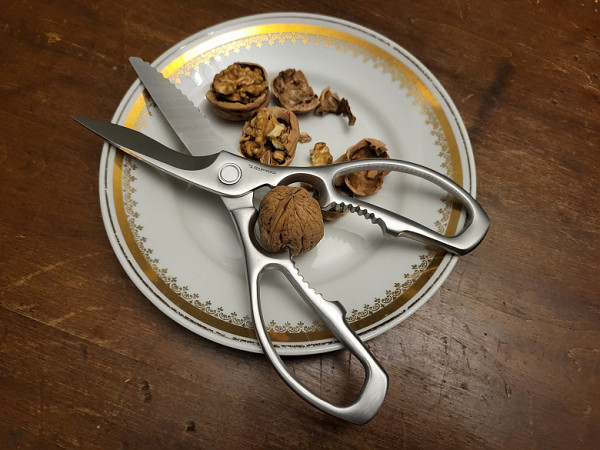
During the testing process, we also used them to open paper bags, cut plastic bags and just paper, and the scissors performed excellently in all cases.
Result: excellent
conclusions
We were very impressed with the knives in the Rawmid set that we tested: they are beautiful, sharp and very functional. It is convenient to work with them when slicing a wide variety of products: meat, sausage, onions, carrots — they cope with any task.
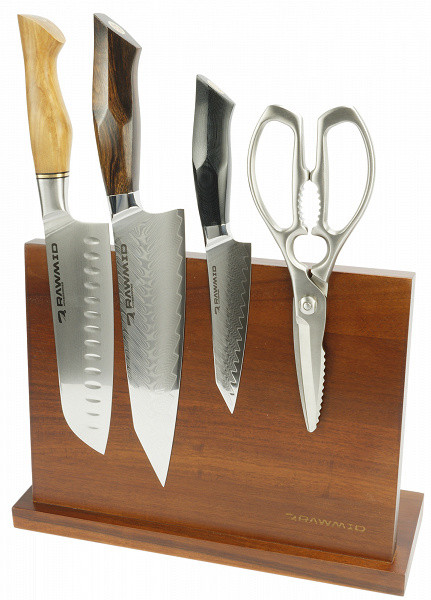
The scissors included in the set also proved to be multi-functional and performed well: we used them to chop onions and chicken, as well as to crack nuts. We are sure that they will cope with both cutting pizza and opening bottles.
Pros:
- Beautiful design
- good gift
- Ease of use
Minuses:
- stains appeared on the Santoku knife during use

